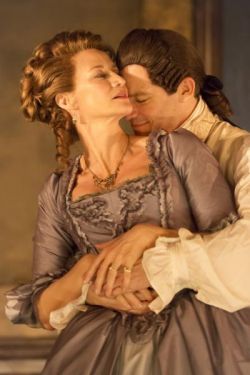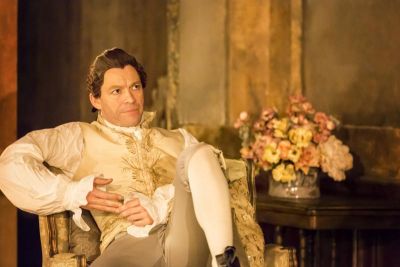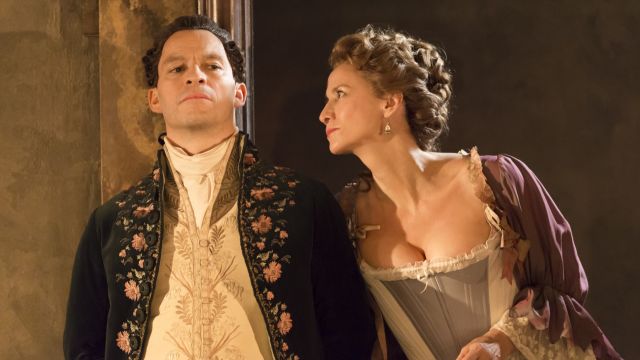Les Liaisons Dangereuses
The source material for this enduring play is Choderlos de Laclos’ novel, Les Liaisons Dangerous, first published in 1782. It is a tale of deceit, betrayal, hypocrisy and sex games among the French aristocracy. Although frequently banned, the novel has been in print ever since, probably because the world and people don’t change that much – and the baroque trappings, the lace and the stays, and the amorality of these 18th century aristos all enable us to contemplate these vices with some objectivity. And it has an implicit feminist argument by way of a merciless depiction of the good old ‘double standard’ – which, it seems, is still with us.
De Laclos, an artillery officer, bored and frustrated on a Bay of Biscay island, decided to write a novel (the first and only one he wrote) in the fashion of his times, a tale told entirely in letters between the his characters. His novel would be, he claimed, ‘something that would resound around the world even after I had left it’. A large claim, but he was right, but not I think merely because of the novel’s scandalous sexuality. There are also its delicious ironies, its piercing psychological acuity across a range of widely differing characters and a plot that creates a gripping tension. In its way, the novel is already drama: there is no authorial narration or comment – just the letters in different ‘voices’. Christopher Hampton extracted the story from the novel’s 395 pages and turned letters into scenes and drama.
 Josie Rourke’s assured revival of Hampton’s adaptation (the play was first produced in 1985 with the late Alan Rickman) accents the game playing and the comedy in its first half. There’s a risk in that: the ‘clever’ characters seem rather arch and too obviously smirking in their enjoyment of their cleverness. But that tone sets up and enables a growing and finally enveloping darkness in the second half. The characters are still ‘clever’, but there is less and less fun in the games and deceptions. Something alien and all too awkward – love – inadvertently inserts itself and disrupts cold and careful calculation. All that can follow is suddenly raw emotion, revenge and death.
Josie Rourke’s assured revival of Hampton’s adaptation (the play was first produced in 1985 with the late Alan Rickman) accents the game playing and the comedy in its first half. There’s a risk in that: the ‘clever’ characters seem rather arch and too obviously smirking in their enjoyment of their cleverness. But that tone sets up and enables a growing and finally enveloping darkness in the second half. The characters are still ‘clever’, but there is less and less fun in the games and deceptions. Something alien and all too awkward – love – inadvertently inserts itself and disrupts cold and careful calculation. All that can follow is suddenly raw emotion, revenge and death.
Dominic West as the roué le Vicomte de Valmont displays his great range as an actor, here giving Valmont an edge of earthy sexuality under his oh-so-calculated manipulations, but adding (a quality Mr West often employs) a sense that his character is not quite as smart as he thinks he is, not quite as in control, and then only realising that when it is too late. Despicable as Valmont might be, however, he is witty and fascinating and we readily fall into the moral trap of wanting him to succeed.
But the show surely belongs to Janet McTeer as Madame de Merteuil, Valmont’s past lover. Ms McTeer has authority, hauteur when needed, froideur when needed, and a ‘warmth’ that schmoozes her gulls and victims. She radiates intelligence so that Merteuil’s great speech (distilled from pages and pages of the novel) about how she invented herself – how she had to invent herself – as a woman is convincing and chilling. It’s beautifully counterpointed by Mr West’s Valmont not really getting the point and smiling complacently though this revelation from his dangerous antagonist. Ms McTeer also has the advantage of being beautiful – an essential element of the sexual chemistry between Merteuil and Valmont.
As Cecile de Volange, Morfydd Clark is a suitably milky victim whose naïve lust is awakened, although the consequences occur off-stage. Adjoa Andoh’s Madame de Volange unfortunately begins loud and arch and stays there without much nuance or variation. Were she a better actor, the ‘colour blind casting’ would be less of a distraction. Jennifer Saayeng, as the totally functional courtesan Emilie, is cheerful, voluptuous and amused. Una Stubbs gives us her ever-reliable slightly ditzy sweetness - and yet, softly and tentatively, knowing exactly what is going on. Edward Holcroft, recognisable from many gritty Brit crime and cop shows, is a convincing Chevalier Danceny. ‘Like most intellectuals, he is profoundly stupid,’ says Merteuil. Mr Holcroft is so ‘sincere’ that you almost forget that he’s as much a deceitful hypocrite as the others.

Truly, this is a nest of vipers – albeit entertaining vipers. The exception is Madame de Tourvel, the citadel of virtue whom Valmont is driven to besiege and assault. Elaine Cassidy doesn’t seem quite right to me. Her Tourvel is, rather than sternly if prissily hostile, overwhelmed and uncertain in a teenage kind of way. She is also let down by her wardrobe: described as dowdy, with high collars, she appears as do the other women, with bursting décolletage. It doesn’t help: we might wonder what Valmont sees in her besides the challenge of her probity and chastity, and we wonder how it is that she can make a man like him happy.
The benefit and the privilege of National Theatre Live presentations are that we get to see the very best actors with the very best texts. But while the Donmar Warehouse, a 251-seat theatre, is an intimate setting perfect for a chamber piece like Les Liaisons, it seems at times too intimate for the cameras. The acting can look like over-acting, too fruity by half, and Hampton’s highly intelligent text for highly intelligent, highly articulate characters can sound – or feel – too clever by half, wordy and over-egged. Such lapses are few but striking. They happen because the cameras put performances under far closer scrutiny that if they were really ‘live’. Nevertheless, as these things go, the camera direction here (uncredited on the program) is superior: finely judged and alert to crucial moments.
 That said, Ms Rourke directs her players with sensitivity and a fine sense of the ironies implicit and explicit. She blocks the action on the compact stage for close combat and the spaces of separation – both literal and psychic. Tom Scutt’s insightful design and Mark Henderson’s lighting, complete with chandeliers and real candles, easily moved furniture and paintings large and small, support story and theme. They don’t attempt a slavish reproduction: their work is more of a gesture toward the late 18th century (as indeed is Hampton’s dialogue) than verisimilitude. As the play proceeds, the décor declines into ragged edges and emptiness as the characters’ bubble world collapses in on them – but it does so modestly, seamlessly without drawing attention to itself. Changes to the stage dressing are accomplished by the cast in transitions between scenes. Never have I seen such transitions more fluid, more integrated and in keeping with the scenes themselves.
That said, Ms Rourke directs her players with sensitivity and a fine sense of the ironies implicit and explicit. She blocks the action on the compact stage for close combat and the spaces of separation – both literal and psychic. Tom Scutt’s insightful design and Mark Henderson’s lighting, complete with chandeliers and real candles, easily moved furniture and paintings large and small, support story and theme. They don’t attempt a slavish reproduction: their work is more of a gesture toward the late 18th century (as indeed is Hampton’s dialogue) than verisimilitude. As the play proceeds, the décor declines into ragged edges and emptiness as the characters’ bubble world collapses in on them – but it does so modestly, seamlessly without drawing attention to itself. Changes to the stage dressing are accomplished by the cast in transitions between scenes. Never have I seen such transitions more fluid, more integrated and in keeping with the scenes themselves.
All in all, this is a play well worth reviving, as emotionally ‘relevant’ (if you must) and modern as it ever was, directed and played with panache and skill.
Michael Brindley
Photographer: Johan Persson
Subscribe to our E-Newsletter, buy our latest print edition or find a Performing Arts book at Book Nook.

